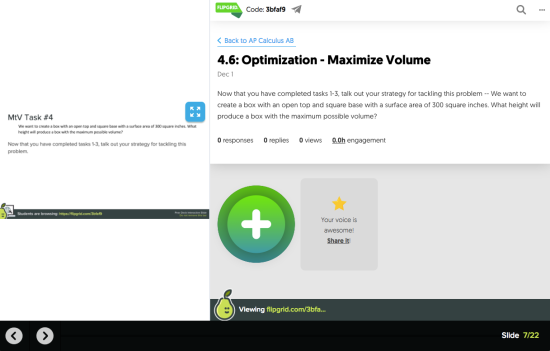If you follow me on Twitter, you’ll see that I recently tweeted that one of my new goals is to use Pear Deck to create student-paced activities with questions that ramp up in difficulty to help students discover new ideas & promote higher-order thinking skills. Since I find that having students chat their ideas out in these discovery-based activities is usually most effective, I looked to Flipgrid to assist in reaching this goal. And then I discovered how easy it is to embed a Flipgrid topic into a Pear Deck using a “web slide”. And so this activity came to life.

We are currently studying optimization in AP Calculus. In solving these problem types, the calculus involved is the simple part for students at this point. What’s challenging is knowing what equations to use to model the scenario. Many times, students try to ‘memorize’ the various setups and then have a hard time when presented with a new type of question because they are not breaking the question down and thinking through – what is given, what is missing, and what are we trying to optimize?
So what I decided to do was take one question type — a box with an open top — and ask three different optimization questions related to this box:
- maximize the volume of the box
- minimize the material used to build the box
- minimize the cost of constructing the box

I had students respond to a series of questions leading up to solving each of the above questions:
- draw a picture; label what’s given & what you’re trying to find
- write out what you’re trying to optimize; what formula will represent that
- what other information does the question provide that might help you solve this question; what type of formula can you come up with to represent this information
- in Flipgrid, talk out your strategy for tackling this problem

After responding to all these pre-tasks, I finally ask students to solve the problem.
Within the Pear Deck, I also layered in some other reflection questions, such as:
- what if, instead of creating a box with an open top, you included the top in the construction; what would change; how would your equations change to reflect this
- why do you think I created this assignment for you; what is the relationship between the questions asked in this activity
- what did this exercise help clarify
If you are interested in seeing this activity, you can find it here:
Let’s Talk About Optimization: Pear Deck Activity
By the end of this activity, my hope is that optimization problems will seem less intimidating for my students. Through the prompts I’ve asked in Pear Deck, and by embedding reflection questions along the way, students are required to give their own meaning to each step. In understanding this process, students can gain a deeper understanding of how to visualize and model a broad range of scenarios. That is my goal, at least.

How did you insert the flipgrid assignment into the slides? You did not explain that
Hi Robin – I first created the question in Flipgrid and then went to my slides and used the Pear Deck Add-On and chose Website for the question type. From there, I just pasted in the Flipgrid share link. When you do that, you won’t actually see the Flipgrid embedded in your Google Slides… students will see that on their end when they log in though. Hope that clarifies!
Pingback: My #BLC19 Presentation Resources — Making Thinking Visible: Embracing #EdTech to Give All Students an Equal Voice @PearDeck @Flipgrid @SutoriApp #TechWithHeart | techieMusings
Pingback: Enhancing Assessments to Drive Instruction with Pear Deck – Cory Cummings
Pingback: Sharing Diigo Links and Resources (weekly) | Another EducatorAl Blog